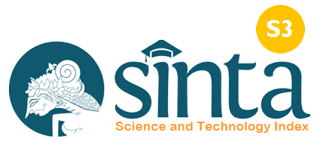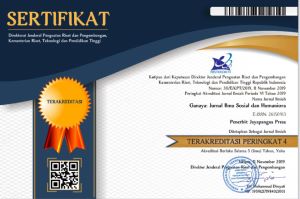Validitas Pengembangan Modul Pembelajaran Fisika Berbasis Etnosains Wisata Pantai Bangsring Underwater Untuk Meningkatkan Kemampuan Literasi Sains Siswa SMA
DOI:
https://doi.org/10.37329/cetta.v8i4.4884Keywords:
Ethnoscience, Learning Module, Science LiteracyAbstract
This study aims to describe the validity of the Bangsring Underwater Tourism Ethnoscience-Based Physics Learning Module and its effect on high school students' science literacy skills. Research and development used the 4D model. Data were collected using validity instruments and then analyzed descriptively. The module validity research instrument had 7 assessment indicators, namely construct, language, content feasibility, presentation feasibility, science literacy elements, ethnoscience elements, and module elements. The research subjects were three lecturers who were experts in science education. The results of the instrument assessment by expert lecturers were validated using Aikens' V formula. The validity results showed that the Bangsring Underwater Ethnoscience-Based Module met the “highly valid” category with an average percentage of 91.5%. The Bangsring Underwater Ethnoscience-Based Physics Learning Module was declared highly valid for improving the science literacy skills of high school students.
References
Akbar, S. (2013). Instrumen Perangkat Pembelajaran. Bandung: Remaja Rosdakarya.
Akbar, S. (2015). Instrumen Perangkat Pembelajaran. Bandung: Remaja Rosdakarya.
Almuharomah, F. A., Mayasari, T., & Kurniadi, E. (2019). Pengembangan Modul Fisika STEM Terintegrasi Kearifan Lokal “Beduk” Untuk Meningkatkan Kemampuan Berpikir Kreatif Siswa SMP. Berkala Ilmiah Pendidikan Fisika, 7(1), 1–10.
Andriani, D. G. (2019). Validasi Modul Berbasis Literasi Pada Mata Kuliah Statistika Matematika. Jurnal Math Educator Nusantara: Wahana Publikasi Karya Tulis Ilmiah Di Bidang Pendidikan Matematika, 5(01), 36–42.
Ardiyanti, Y., Suyanto, S., & Suryadarma, I. G. P. (2019, October). The Role of Students’ Science Literacy in Indonesia. In Journal of Physics: Conference Series (Vol. 1321, No. 3, p. 032085). IOP Publishing.
Apriani, N. W. R., Doyan, A., Sridana, N., & Susilawati, S. (2020). The Validity of Physical Learning Device Based on Discovery Learning Model Assisted by Virtual Laboratory. Jurnal Penelitian Pendidikan IPA, 6(2), 132–135.
Dewi, C. A., Khery, Y., & Erna, M. (2019). An Ethnoscience Study in Chemistry Learning to Develop Scientific Literacy. Jurnal Pendidikan IPA Indonesia, 8(2), 279–287.
Deviana, T. (2018). Analisis Kebutuhan Pengembangan Modul Pembelajaran Berbasis Kearifan Lokal Kabupaten Tulungagung Untuk Kelas V SD Tema Bangga Sebagai Bangsa Indonesia. Jurnal Pemikiran dan Pengembangan Sekolah Dasar (JP2SD), 6(1), 47–56.
Ferdyan, R., & Arsih, F. (2021). Analisis Kemampuan Literasi Sains dan Keterampilan Berpikir Kritis Siswa Terhadap COVID-19 Berdasarkan Materi yang Relevan dalam Pembelajaran Biologi. Bio-Lectura: Jurnal Pendidikan Biologi, 8(2), 106–118.
Fuad, Z., Sholahuddin, A., & Mahardika, A. I. (2024). Integration of Local Wisdom of Natural Color Sasirangan in Project-Based Learning with STEAM Approach to Train Science Literacy. JPPI (Jurnal Penelitian Pendidikan Indonesia), 10(4), 505–514.
Haryadi, R., & Nurmala, R. (2021). Pengembangan Bahan Ajar Fisika Kontekstual dalam Meningkatkan Motivasi Belajar Siswa. SPEKTRA: Jurnal Kajian Pendidikan Sains, 7(1), 32–39.
Junaidi, J., Rahmasari, S., & Fitriah, L. (2022). Pengembangan Bahan Ajar Gerak Harmonik Literasi Sains dan Minat Pada Konsep Gerak Melingkar Sederhana Berbasis Etnosains Tradisi Baayun Maulid. Jurnal Kependidikan, 7(1), 63–68.
Kristyowati, R., & Purwanto, A. (2019). Pembelajaran Literasi Sains Melalui Pemanfaatan Lingkungan. Scholaria: Jurnal Pendidikan dan Kebudayaan, 9(2), 183–191.
Larasati, S. R., & Rukmana, D. (2024). Pengembangan E-Modul Book Creator Berbasis Pendekatan Saintifik dan Keterampilan Berpikir Kreatif Pada Pembelajaran IPA Siswa Kelas IV Sekolah Dasar. ELSE (Elementary School Education Journal), 8(3), 21–31.
Marsila, N. (2025). Development of an Acid-Base E-Module Based on Guided Discovery Learning with Ethnoscience Content to Improve Literacy and Numeracy. Jurnal Penelitian Pendidikan IPA, 11(8), 1125–1135.
Nurcahyani, D., Rahmayanti, H., Ichsan, I. Z., & Rahman, M. M. (2021, February). Ethnoscience Learning on Science Literacy of Physics Material to Support Environment: A Meta-Analysis Research. In Journal of Physics: Conference Series (Vol. 1796, No. 1, p. 012094). IOP Publishing.
Sugiyono. (2012). Metode Penelitian Pendidikan (Pendekatan Kuantitatif, Kualitatif dan R & D). Bandung: Alfabeta.
Sugiyono. (2017). Metode Penelitian Kuantitatif Kualitatif dan R dan D. Bandung: Alfabeta.
Supit, M. W. M., Dharmono, D., & Riefani, M. K. (2021). Validitas Buku Saku Famili Myrtaceae di Kawasan Mangrove Desa Sungai Bakau Berbasis 3D Pageflip. Oryza: Jurnal Pendidikan Biologi, 10(2), 19–25.
Thiagarajan, S., Semmel, D. S., & Semmel, M. I. (1974). Instructional Development for Training Teachers of Exceptional Children. Indiana: Indiana University Bloomington.
Uslan, U., Abdullah, N., Imami, M. K. W., & Aiman, U. (2024). The Effectiveness of the Local Knowledge-Based Module (LKBM) to Improve Students’ Scientific Literacy and Thinking Skills. Jurnal Pendidikan IPA Indonesia, 13(1), 147–161.
Valladares, L. (2021). Scientific Literacy and Social Transformation: Critical Perspectives About Science Participation and Emancipation. Science & Education, 30(3), 557–587.
Winarni, E. W., Hambali, D., & Purwandari, E. P. (2020). Analysis of Language and Scientific Literacy Skills for 4th Grade Elementary School Students Through Discovery Learning and ICT Media. International Journal of Instruction, 13(2), 213–222.
Wulan, I. S., Suprapto, P. K., & Kamil, P. M. (2020). Belajar Virus dengan Komik: Pengaruhnya terhadap Motivasi dan Hasil Belajar (Studi Eksperimen di Kelas X MAN Tasikmalaya Tahun Ajaran 2019/2020). Bioedusiana: Jurnal Pendidikan Biologi, 5(2), 70–83.
Yim, L. W. K., Lye, C. Y., & Koh, P. W. (2024). A Psychometric Evaluation of an Item Bank for an English Reading Comprehension Tool Using Rasch Analysis. REID (Research and Evaluation in Education), 10(1), 18–34.
Downloads
Published
How to Cite
Issue
Section
License
Copyright (c) 2025 Linda Agustina, Rayendra Wahyu Bachtiar, Bea Hana

This work is licensed under a Creative Commons Attribution-ShareAlike 4.0 International License.
An author who publishes in the Cetta : Jurnal Ilmu Pendidikan agrees to the following terms:
- Author retains the copyright and grants the journal the right of first publication of the work simultaneously licensed under the Creative Commons Attribution-ShareAlike 4.0 License that allows others to share the work with an acknowledgement of the work's authorship and initial publication in this journal
- Author is able to enter into separate, additional contractual arrangements for the non-exclusive distribution of the journal's published version of the work (e.g., post it to an institutional repository or publish it in a book) with the acknowledgement of its initial publication in this journal.
- Author is permitted and encouraged to post his/her work online (e.g., in institutional repositories or on their website) prior to and during the submission process, as it can lead to productive exchanges, as well as earlier and greater citation of the published work (See The Effect of Open Access).
Read more about the Creative Commons Attribution-ShareAlike 4.0 Licence here: https://creativecommons.org/licenses/by-sa/4.0/.





